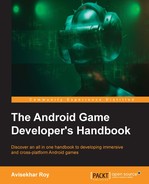- The Android Game Developer's Handbook
- Table of Contents
- The Android Game Developer's Handbook
- Credits
- About the Author
- About the Reviewer
- www.PacktPub.com
- Preface
- 1. Android Game Development
- 2. Introduction to Different Android Platforms
- Exploring Android mobiles
- Exploring Android tablets
- Exploring Android televisions and STBs
- Exploring Android consoles
- Exploring Android watches
- Development insights on Android mobiles
- Development insights on Android tablets
- Development insights on Android TV and STBs
- Development insights on Android consoles
- Development insights on Android watches
- Platform-specific specialties
- Summary
- 3. Different Android Development Tools
- 4. Android Development Style and Standards in the Industry
- 5. Understanding the Game Loop and Frame Rate
- 6. Improving Performance of 2D/3D Games
- 2D game development constraints
- 3D game development constraints
- The rendering pipeline in Android
- Optimizing 2D assets
- Optimizing 3D assets
- Common game development mistakes
- 2D/3D performance comparison
- Summary
- 7. Working with Shaders
- 8. Performance and Memory Optimization
- Fields of optimization in Android games
- Resource optimization
- Design optimization
- Memory optimization
- Don't create unnecessary objects during runtime
- Use primitive data types as far as possible
- Don't use unmanaged static objects
- Don't create unnecessary classes or interfaces
- Use the minimum possible abstraction
- Keep a check on services
- Optimize bitmaps
- Release unnecessary memory blocks
- Use external tools such as zipalign and ProGuard
- Performance optimization
- Relationship between performance and memory management
- Memory management in Android
- Processing segments in Android
- Different memory segments
- Importance of memory optimization
- Optimizing overall performance
- Increasing the frame rate
- Importance of performance optimization
- Common optimization mistakes
- Best optimization practices
- Summary
- Fields of optimization in Android games
- 9. Testing Code and Debugging
- 10. Scope for Android in VR Games
- Understanding VR
- VR in Android games
- Future of Android in VR
- Game development for VR devices
- Introduction to the Cardboard SDK
- Basic guide to develop games with the Cardboard SDK
- VR game development through Google VR
- Android VR development best practices
- Challenges with the Android VR game market
- Expanded VR gaming concepts and development
- Summary
- 11. Android Game Development Using C++ and OpenGL
- 12. Polishing Android Games
- 13. Third-Party Integration, Monetization, and Services
- Google Play Services
- Multiplayer implementation
- Analytic tools
- Android in-app purchase integration
- Android in-game advertisements
- Monetization techniques
- Planning game revenue
- User acquisition techniques
- User retention techniques
- Featuring Android games
- Publishing Android games
- Summary
- Index
We looked at Android NDK briefly in this chapter and cleared a few doubts on native development. There are many developers who think that developing games in a native language gives enormous processing power. This is, however, not always true. Processing and performance depend on the development style and standard. In most common scenarios, the difference between native development and SDK development is negligible.
OpenGL works with Android in any scenario. The backend rendering is based on OpenGL for both NDK and SDK. We have already discussed all the technical aspects of OpenGL. Here, you learned which version of OpenGL works with Android and what we should use. Clearly, OpenGL ES 2.0 is a good choice as most Android devices support it. On the other hand, OpenGL ES 1.0 is obsolete, and OpenGL ES 3.0 is not supported by most Android devices yet.
Until now, we have covered almost every aspect of Android game development. However, finishing the implementation for the game does not define the completion of the development cycle. Developers need to polish the game after it comes to a release-ready state to improve its overall quality. We will discuss game polishing in the next chapter to indicate the completion of the game development process.
-
No Comment
